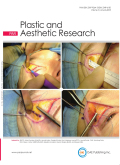- 钛学术文献服务平台 \
- 学术期刊 \
- 医药卫生期刊 \
- 外科学期刊 \
- 整形与美容研究(英文版)期刊 \
Environmental aging of the skin: new insights
Environmental aging of the skin: new insights
基本信息来源于合作网站,原文需代理用户跳转至来源网站获取
摘要:
The appearance of aging is determined primarily by extrinsic factors through exposure to environmental sunlight and airborne pollution. That solar ultraviolet B (λ = 290-320 nm) directly causes photoaging (with wrinkles, dryness, and mottled pigmentation) and skin cancer has been recognized for decades; the contribution by ultraviolet A (λ = 320-400 nm) was only more recently understood. New research further implicates visible light (λ = 400-700 nm) as well as the heat rays of infrared radiation (λ > 800 nm). Particularly in urban environments, airborne pollutants such as ozone (O3), polycyclic aromatic hydrocarbons, particulate matter (PM) in smog, and tobacco smoke contribute to photoaging and skin cancer. Furthermore, exposure simultaneously to both solar ultraviolet (UV) and these pollutants results in even greater synergistic damage. The volatile pollutants generate reactive oxygen species which oxidize surface lipids leading to deeper damaging inflammatory reactions. PM carries high concentrations of environmental organic compounds and trace metals. These pollutant-laden particles deliver toxins to the skin transcutaneously through hair follicles and through the blood after respiratory inhalation. The predominant natural mechanism of clearing these xenobiotic chemicals is through the ligand-activated transcription factor the arylhydrocarbon receptor (AHR) found on all skin cells. AHR activity regulates keratinocyte differentiation and proliferation, maintenance of epidermal barrier function, melanogenesis, and immunity. With chronic activation by UV exposure and pollutants, AHR signaling contributes to both extrinsic aging and carcinogenesis.

推荐文章
Magnetic Influences of Cement Dust on Soil in Industrial Area and Its Environmental Implications
Cement dust
Soil
Magnetic property
Environmental significance
Geochemical assessment, mixing behavior and environmental impact of thermal waters in the Guelma geo
Geochemistry
Geothermometry
Mixing
Thermal effluents
Guelma
Algeria
Genesis and soil environmental implications of intact in-situ rhizoliths in dunes of the Badain Jara
Rhizoliths
Calcification
Leptic regosols
Artemisia roots
Decomposition
Soil moisture
内容分析
关键词云
关键词热度
相关文献总数
(/次)
(/年)
文献信息
| 篇名 | Environmental aging of the skin: new insights | ||
| 来源期刊 | 整形与美容研究(英文版) | 学科 | |
| 关键词 | |||
| 年,卷(期) | 2020,(10) | 所属期刊栏目 | Review |
| 研究方向 | 页码范围 | 86-101 | |
| 页数 | 16页 | 分类号 | |
| 字数 | 语种 | 英文 | |
| DOI | 10.20517/2347-9264.2020.154 | ||
五维指标
引文网络
引文网络
二级参考文献 (0)
共引文献 (0)
参考文献 (59)
节点文献
引证文献 (0)
同被引文献 (0)
二级引证文献 (0)
1962(1)
- 参考文献(1)
- 二级参考文献(0)
1969(1)
- 参考文献(1)
- 二级参考文献(0)
1979(1)
- 参考文献(1)
- 二级参考文献(0)
1984(1)
- 参考文献(1)
- 二级参考文献(0)
1988(1)
- 参考文献(1)
- 二级参考文献(0)
1990(1)
- 参考文献(1)
- 二级参考文献(0)
1991(2)
- 参考文献(2)
- 二级参考文献(0)
1992(3)
- 参考文献(3)
- 二级参考文献(0)
1995(1)
- 参考文献(1)
- 二级参考文献(0)
1997(1)
- 参考文献(1)
- 二级参考文献(0)
2000(2)
- 参考文献(2)
- 二级参考文献(0)
2001(3)
- 参考文献(3)
- 二级参考文献(0)
2003(3)
- 参考文献(3)
- 二级参考文献(0)
2004(1)
- 参考文献(1)
- 二级参考文献(0)
2005(3)
- 参考文献(3)
- 二级参考文献(0)
2006(1)
- 参考文献(1)
- 二级参考文献(0)
2007(2)
- 参考文献(2)
- 二级参考文献(0)
2009(2)
- 参考文献(2)
- 二级参考文献(0)
2010(3)
- 参考文献(3)
- 二级参考文献(0)
2011(1)
- 参考文献(1)
- 二级参考文献(0)
2012(2)
- 参考文献(2)
- 二级参考文献(0)
2013(2)
- 参考文献(2)
- 二级参考文献(0)
2014(2)
- 参考文献(2)
- 二级参考文献(0)
2015(6)
- 参考文献(6)
- 二级参考文献(0)
2016(3)
- 参考文献(3)
- 二级参考文献(0)
2017(2)
- 参考文献(2)
- 二级参考文献(0)
2018(4)
- 参考文献(4)
- 二级参考文献(0)
2019(3)
- 参考文献(3)
- 二级参考文献(0)
2020(1)
- 参考文献(1)
- 二级参考文献(0)
2020(1)
- 参考文献(1)
- 二级参考文献(0)
- 引证文献(0)
- 二级引证文献(0)
引文网络交叉学科
相关学者/机构
期刊影响力
整形与美容研究(英文版)
主办单位:
出版周期:
月刊
ISSN:
2347-9264
CN:
开本:
出版地:
陕西省西安市高新区绿地SOHO B座1705室
邮发代号:
创刊时间:
语种:
eng
出版文献量(篇)
440
总下载数(次)
0
总被引数(次)
32
期刊文献
相关文献
推荐文献
- 期刊分类
- 期刊(年)
- 期刊(期)
- 期刊推荐
整形与美容研究(英文版)2022
整形与美容研究(英文版)2021
整形与美容研究(英文版)2020
整形与美容研究(英文版)2019
整形与美容研究(英文版)2018
整形与美容研究(英文版)2017
整形与美容研究(英文版)2016
整形与美容研究(英文版)2015
整形与美容研究(英文版)2014
整形与美容研究(英文版)2020年第9期
整形与美容研究(英文版)2020年第8期
整形与美容研究(英文版)2020年第7期
整形与美容研究(英文版)2020年第6期
整形与美容研究(英文版)2020年第5期
整形与美容研究(英文版)2020年第4期
整形与美容研究(英文版)2020年第3期
整形与美容研究(英文版)2020年第2期
整形与美容研究(英文版)2020年第12期
整形与美容研究(英文版)2020年第11期
整形与美容研究(英文版)2020年第10期
整形与美容研究(英文版)2020年第1期

 免费查重
免费查重










